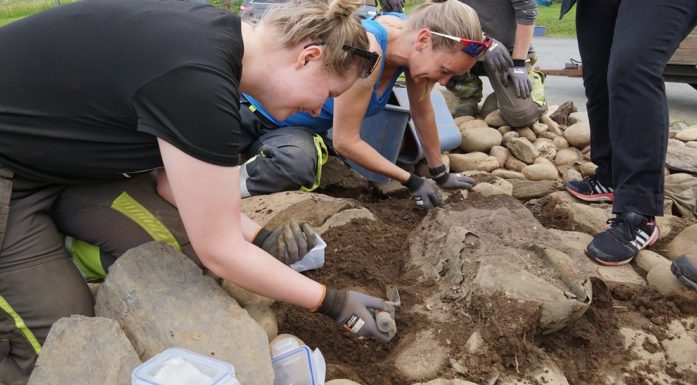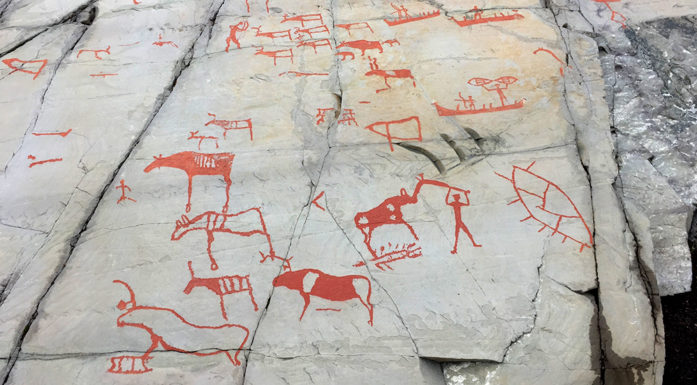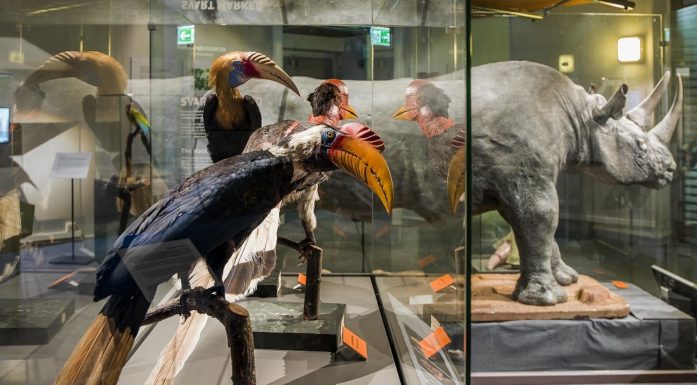Unique Middle Age tapestry gives insight into medieval times
Norwegian churches in the Middle Ages were decorated with embroidered tapestries that told Bible stories almost like a comic series. The Høylandet tapestry is the only one of its kind that has survived the march of time.
About 800 years ago a group of women gathered in the village of Høylandet in northern Trøndelag County to embroider a long tapestry. They came from prosperous farms and high-status families that had enough resources to allow the women from the farm to embroider instead of contribute to the crop harvesting.
The women sketched scenes from the Bible onto the woven red ground, and then filled in the characters and figures with different embroidery techniques in vivid colours. The height of the tapestry is 44 cm and its original length is unknown. It was probably very long and represented a lot of work. The tapestry was likely made for a stave church in Høylandet.
Hidden and forgotten
At some point in history, the tapestry was stowed away in the loft of Høylandet Church. It lay there, hidden and forgotten.
“This stowage served as an excellent conservation technique. Pure luck!” says Ingrid Lunnan Nødseth.

Ingrid Lunnan Nødseth studies preserved church textiles from the Scandinavian late Middle Ages. She is especially concerned with how church textiles define and adorn the holy space and the holy body (corpus mysticum) of medieval culture. Nødseth is a PhD candidate in art history at NTNU.
Nødseth is a PhD candidate in art history at NTNU and is writing her doctoral dissertation on this very tapestry from Høylandet. She puts on white gloves and takes us into a room with muted lighting in the NTNU University Museum. The 800-year-old textile needs to be treated gently and exposed to minimal light and other external impacts.
The tapestry is made of wool yarn dyed with plants and minerals. Plant-dyed wool doesn’t keep well over time and gradually fades from exposure to light. This is one reason why only one of the tapestries that so richly decorated Norwegian medieval churches has been preserved. In addition to the fragile nature of the tapestry materials, textiles were often repurposed after the Reformation, which contributed to their disappearance from the churches.
The Høylandet tapestry is unique in its kind and provides insight into the medieval techniques and use of motifs.
“This is the most important example of embroidery that has been preserved from the Norwegian Middle Ages,” says Nødseth.
The Høylandet tapestry is unique in its kind and provides insight into the medieval techniques and use of motifs.
“It’s like a textile comic strip that depicts scenes from the Bible stories. This type of tapestry was very common in the Middle Ages, as was having textiles in churches. But almost none of them have been preserved. That’s why the Høylandet tapestry is so special,” she says of the 210 cm long and 44 cm wide embroidery.
Related to the Bayeux Tapestry
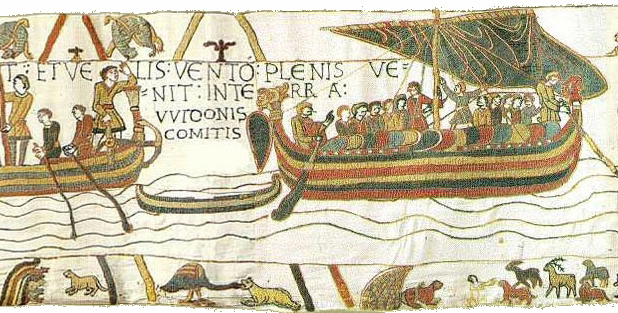
Section from the Bayeux tapestry that is part of UNESCO’s Memory of the World Programme. The embroidered caption relates the story that Harold sailed by sea “and with sails filled with wind came to the land of Count Wido.”
The Høylandet tapestry can be compared with another tapestry from about the same time: the Bayeux Tapestry in Normandy, France. This 70-meter-long embroidered work describes William the Conqueror’s invasion of England and the Battle of Hastings in 1066.
However, a distinguishing feature between the two treasures is that the Bayeux Tapestry is worldly and tells a story of war, while the motifs of the Høylandet tapestry take us straight to the core of Christian motifs. The Norwegian artefact is an example of embroidered picture friezes made to adorn the rooms of medieval churches.
Embroidered in vivid colours
Today, the colours have faded to shades of brown, but originally the embroiderers used yarns with strong, bright colours. The woven ground was red and was embroidered with blue, green, ochre, yellow and red wool yarn. White linen thread was used to outline the figures and forms.
It’s like a textile comic strip that depicts scenes from the Bible stories.
“A lot of work went into this tapestry and I imagine that several women worked on it together. We know very little about who made the rug, but we know that doing embroidery was a high status activity. Prosperous farms could afford to let the wife and daughters spend time on embroidery,” says Nødseth.
“In the Høylandet tapestry we find great pattern and technique variations. For example, the horse is filled with nine different embroidery patterns. It’s embroidered with a so-called fill stitch, a technique only found in Scandinavia. It’s a sign that the work belongs to a Nordic context,” she says.
Insulated against the winter cold
The tapestry was found wrapped up in the loft of Høylandet Church in the 1800s, and luckily it found its way to the NTNU University Museum where it has been well taken care of.
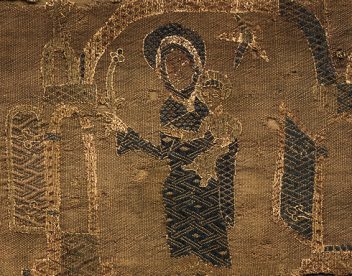
The Virgin Mary proudly presents the infant Jesus to the three wise men. Photo: Haugan / NTNU University Museum
“In the early 1900s we became aware that the textiles tell an important part of our story,” says Nødseth.
She adds, “We have written sources that tell us that the choir in medieval churches was hung with textiles and that other parts of the church were adorned with tapestries, especially on holy days.”
In addition to decorating the church, the textiles served to help insulate against the winter cold. But time has tarnished the textiles over the centuries. Apart from this two-meter-long Høylandet tapestry fragment, only small remnants of textiles have been found in other churches.
“Embroidered fragments using the same technique were found under the floors of the stave churches in Lom and Urnes during the excavations there. We’ve also found nails in the walls of stave churches like Hopperstad, which may have been used for hanging textiles,” says Nødseth.
Scenes from the Nativity
The Høylandet tapestry contains three image motifs. The first scene shows the three wise men, Caspar, Melchior and Balthazar, who come to pay homage to the Jesus child with gold, frankincense and myrrh. In the Middle Ages, the men were portrayed as three holy kings. In the Høylandet tapestry, they are wearing short pants and robes draped over their shoulders; two of them have small crowns and one has a Phrygian hat. Their clothing shows that they have come from the East.
Article continues below image.

The fragment shows the three wise men, Caspar, Melchior and Balthazar, who come to pay homage to the Jesus child with gold, frankincense and myrrh. Photo: Idun Haugan / NTNU University Museum
The second scene shows the Virgin Mary sitting on a throne like a heavenly queen. She proudly holds out the baby Jesus toward the three wise men.
The last scene is derived from the three kings’ dream. The prophecies about the birth and role of Jesus concern Herod, who orders the three wise men to report back to him where Jesus is. The wise men are warned in a dream not to return to Herod, and so they do not reveal Jesus’ location.
“The scenes take us right into the Christmas story, and the tapestry was probably hung up at least at Christmastime, and maybe also for other festivals and holidays,” Nødseth says.
“The Høylandet tapestry is special because it’s so old and also because it offers insight into a time and an image world and a tradition that we know little about,” she adds.
Nødseth hopes her doctorate will allow her to learn more about the role of church textiles in the Middle Ages.
